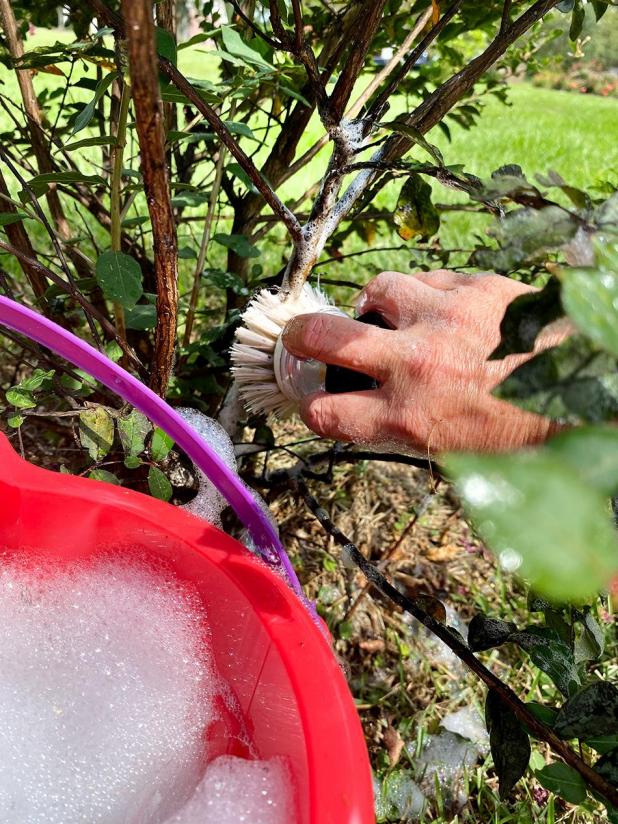
Use a soapy mixture with a soft brush to wash scales away.
—LSU AgCenter/Heather Kirk-Ballard
Get It Growing: Scale insects infest crape myrtles
It first showed up in Texas in 2004 and made its way across the Gulf States. Now, crape myrtle bark scale can be found as far west as New Mexico, as far north as Kansas and as far east as Virginia. It is most prevalent in Texas and Louisiana.
Crape myrtle bark scale is an introduced insect pest from Asia, and it has great affinity for crape myrtle trees. The problem usually goes unnoticed until plants begin turning black.
Scales are small insects that are flat and round or oval. They are often soft-bodied, although hard-bodied scales also exist. They are often difficult to detect because the adults attach themselves to the trees and become immobile.
Scales can be brown to white in color, with the white scales being more detectable against green leaves and brown stems. They are most often found on the veins and leaf joints on the upper side of leaves or on the branches and trunks of trees and shrubs.
Scales can be particular in what they like to live on. They especially love members of the magnolia family, such as our Southern magnolia, sweet bay magnolia and banana shrubs.
For crape myrtle bark scale, the favorite host, of course, is the crape myrtle, although it can also be found on other common landscape plants such as American beautyberry, little leaf boxwood, cleyera and privet in addition to edible fruits such as pomegranate, persimmon, raspberries and figs.
Most scale bugs excrete large amounts of sugary waste called honeydew that encourages the growth of sooty mold, a black-colored fungus that interferes with photosynthesis, causing plants to become sickly.
Often, you may first observe the sooty mold or yellowing of leaves where scales have caused their damage. Heavily infested plants reduce new growth, and plants can eventually die.
Crape myrtle bark scale can be found where the name implies — on the bark of the trees — and rarely on the foliage. An overall infestation appears as white to gray in color.
The scales produce large amounts honeydew by sucking sap from the phloem of trees and shrubs with their piercing-sucking mouth parts. Black sooty mold or fungus then grows on the honeydew, covering the leaves and branches of the tree in the telltale sign of the pest.
Several ways are available to help control or eliminate scales; however, it is no easy task to control a heavily infested population. The best way to control crape myrtle bark scale is to ensure that your trees are healthy with the proper amount of sunlight (they prefer full sun), watering, fertilization and weed management and proper pruning techniques.
As always, use chemical control as a last defense. Natural predators such as lady beetles and mealybugs are highly effective when they are in large enough numbers. You can also scrape off the scales or use a high-pressure water hose to spray them off, being careful not to harm the tree.
A soapy water mixture composed of dishwashing liquid with 1½ teaspoons per quart of water or an insecticidal soap and a soft brush can be used to scrub the insects off of limbs and branches that you can reach and simply rinse them away.
Or you can spray the solution, reapplying every five to seven days as needed, covering both sides of the foliage. Leave the solution for several minutes and then rinse the soap and bugs off. Do not apply on a hot, sunny days to prevent burning the plant. This treatment is not easily accomplished on very tall trees but is effective on smaller ones.
Horticultural oil sprays can be applied when temperatures are above 45 degrees and below 90 degrees. Always spray in the late evening to slow drying time and increase effectiveness.
Finally, you can use a chemical control with active ingredients such as acephate, bifenthrin or imidacloprid.
Apply it by spraying directly on the scales or wiping them with a paint sponge, being careful to wear chemical-impermeable gloves. As always, follow directions on the labels and apply in the late evening to reduce the impact on pollinators. These treatments may need to be repeated to control newly hatched immature crawlers.
The most effective treatment for heavy infestation is a systemic insecticide with the active ingredient dinotefuran, imidacloprid or acephate to treat as a soil drench. Systemic insecticides, however, can have harmful effects on pollinators that feed on the pollen and nectar when trees are flowering.
Scale insects are invasive and will infest other plants, so move infested plants away from healthy ones. Unfortunately, sometimes it is best to completely remove and destroy heavily infested plants.
